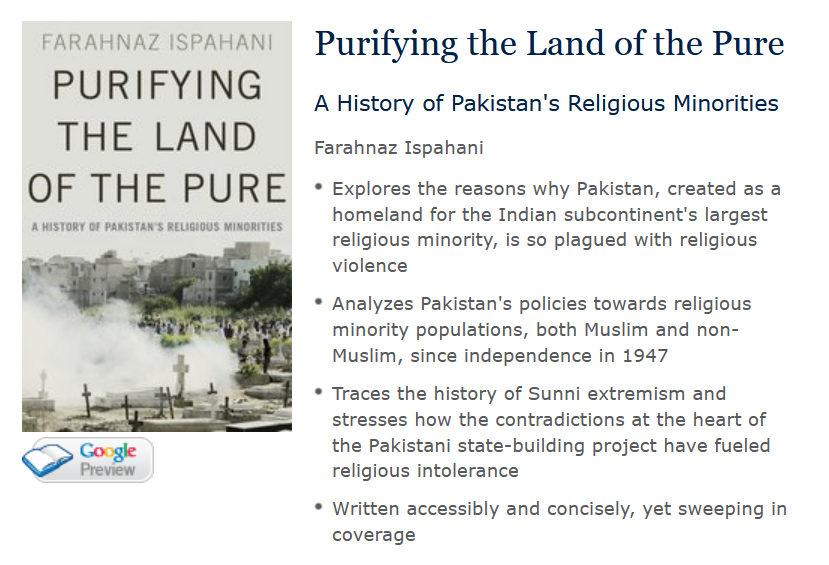Purifying the Land of the Pure: A History of Pakistan’s Religious Minorities, Hindus, Christians, etc
When Pakistan became an independent state in 1947, it sought to provide a new homeland and safe harbor for South Asia’s Muslims, the largest religious minority in the subcontinent at the time. Pakistan at first welcomed all of its new citizens, Muslim and non-Muslim alike. Today, however, Pakistan’s non-Muslims comprise a mere 3 percent of the nation’s population, and in recent years non-Sunnis have been subjected to high levels of persecution and violence. What happened? In Purifying the Land of the Pure, Farahnaz Ispahani analyzes Pakistan’s policies towards its religious minority populations since independence.
Overview
When Pakistan became an independent state in 1947, it sought to provide a new homeland and safe harbor for South Asia’s Muslims, the largest religious minority in the subcontinent at the time. Pakistan at first welcomed all of its new citizens, Muslim and non-Muslim alike. Non-Muslims comprised 23 percent of the total population, and non-Sunni Muslims comprised a quarter of the Muslim population. Today, however, Pakistan’s non-Muslims comprise a mere 3 percent of the nation’s population, and in recent years non-Sunnis have been subjected to high levels of persecution and violence. What happened? In Purifying the Land of the Pure, Farahnaz Ispahani analyzes Pakistan’s policies towards its religious minority populations since independence. She notes the period of transition from an inclusive policy to an exclusive one, citing the influence of a number of religious and political leaders who invoked a new vision for Pakistan. The word “pakistan” is Urdu for “Land of the Pure.” Thus, in their view, the objective for Pakistan’s creation should be more specific and narrow: to create an Islamic state. In 1949, Pakistan’s Constituent Assembly ratified this objective, which set the country on the path it was to follow. But according to Ispahani, the event that accelerated the pace toward intolerance of non-Sunnis was General Zia-ul-Haq’s forceful ascent to power in 1977. His military regime promoted Sunni Islam at the expense of other denominations so that by the end of his reign, Pakistan was no longer a welcome place for minorities. Many fled, but those who remained faced escalating persecution, from both state and non-state actors. Tens of thousands died in the ensuing “purifying” attacks. Ispahani traces this history, stressing how the contradictions at the heart of the Pakistani state-building project have fueled intolerance.
“Farahnaz Ispahani has written, fearlessly and eruditely, the chronicle of a country destroyed by its own intolerance.”
—Leon Wieseltier, Isaiah Berlin Senior Fellow in Culture and Policy, The Brookings Institution


